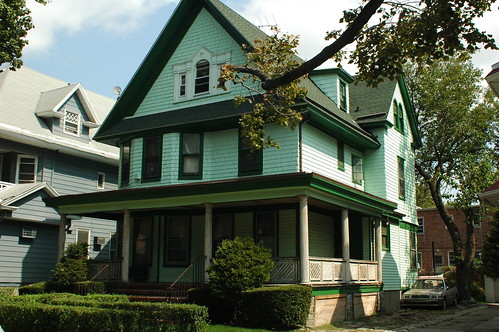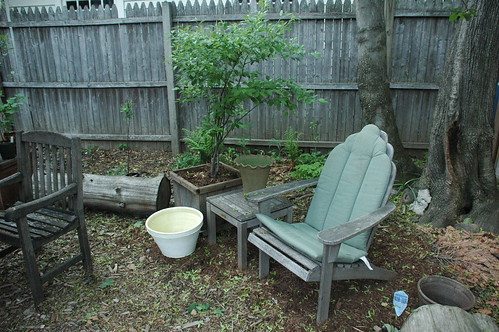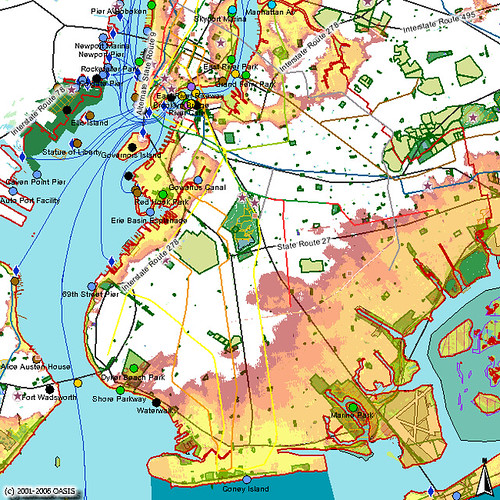Bat House at the East 4th Street Community Garden in Kensington/Windsor Terrace
A discussion thread about mosquito control on the Flatbush Family Network led to this question:
I heard that bat houses are a possible long-term solution for mosquitos. I guess you put a bat house up and hope that they come and live there. It can take a few seasons to get them to do it but an average bat eats lots of mosquitos a day. Seems strange to try and seduce bats to your house but those mosquitos are terrible. Anyone else heard about these bat houses?
The photo above is of a bat house in the East 4th Street Community Garden, which I visited for the first time last November. One of the questions they get when they explain what it’s for is, “Where do you get the bats?” If you build it, they will come. We have bats here in Brooklyn. Whether we will continue to have them is in question.
A newly emerging epidemic is wiping out bat colonies. First discovered last winter in a single cave near Albany, New York, this winter it’s been found to have spread to more locations, including sites in Vermont and Massachusetts. Mortality has been as high as 90% in some caves:
Thousands of hibernating bats are dying in caves in New York State and Vermont from unknown causes … The most obvious symptom involved in the die-off is a white fungus encircling the noses of some, but not all, of the bats. Called “white-nose syndrome,” the fungus is believed to be associated with the problem, but it may not necessarily contribute to the actual cause of death. It appears that the affected bats deplete their fat reserves months before they would normally emerge from hibernation and die as a result …
“What we’ve seen so far is unprecedented,” said Alan Hicks, DEC’s bat specialist. “Most bat researchers would agree that this is the gravest threat to bats they have ever seen. We have bat researchers, laboratories and caving groups across the country working to understand the cause of the problem and ways to contain it.”
– Bat Die-Off Prompts Investigation, New York State Department of Environmental Conservation
Bat populations are particularly vulnerable during hibernation as they congregate in large numbers in caves-clusters of 300 per square foot in some locations-making them susceptible to disturbance or disease. The vast majority of the hundreds of thousands of bats known to hibernate in New York do so in just five caves and mines. Because bats often migrate hundreds of miles to their summer range, effects on hibernating bats can have significant implications for bats throughout the Northeast.
Indiana bats [Myotis sodalis], a state and federally endangered species, are perhaps the most vulnerable. Half the estimated 52,000 Indiana bats that hibernate in the state are located in just one former mine-a mine that is now infected with white-nose syndrome. Eastern pipistrelle [Perimyotis subflavus], northern long-eared [Myotis septentrionalis] and little brown [Myotis lucifugus] bats also are dying. Little brown bats, the most common hibernating species in the state, have sustained the largest number of deaths.
Related Posts
Bat Houses, April 13, 2008
Other posts about bats
Links
Chronology
Bat Die-Off Prompts Investigation, New York State Department of Environmental Conservation
Mystery Disease Kills U.S. Bats, Bat Conservation International
Something is killing our bats: The white-nose syndrome mystery, U.S. Fish and Wildlife Service
Wikipedia: White-nose syndrome
Flatbush Family Network (requires membership)
News
Dying Bats in the Northeast Remain a Mystery, USGS Newsroom, May 9, 2008
First It Was Bees, Now It’s Bats That Are Dying, Natural News, April 11, 2008
Bats in the Region Are Dying From a Mysterious Ailment, Litchfield County Times, April 3, 2008
Bats Perish, and No One Knows Why, New York Times Science Section, March 25, 2008





























